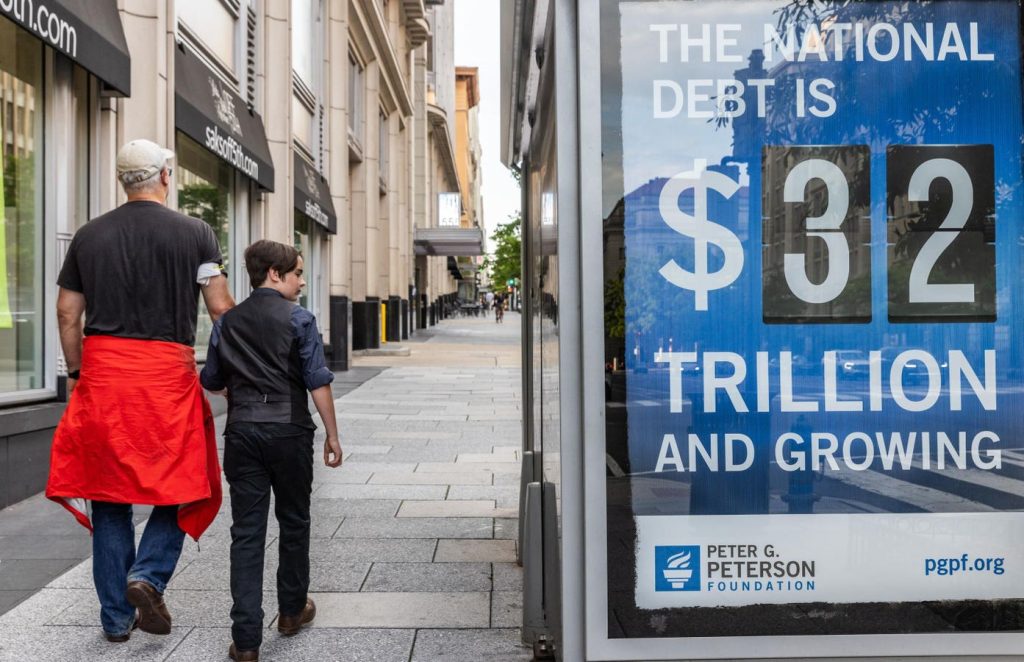There’s plenty of talk about the U.S. $34 trillion public debt. Not deficit — the amount of red ink every year spilled on the country’s accounts — but the cumulative total public debt. But a second number hasn’t received as much attention, although it should. That is the debt service, or the amount of money spent every quarter to satisfy the interest payments on the debt.
In the last quarter of 2023, the amount crossed a monumental threshold of $1 trillion every three months. It is only getting higher.
The national debt is important and a massive amount that, as the Peter G. Peterson Foundation notes, is not just high — the country has been in relatively high levels of debt before — but stratospheric in ways never before true.
In the past, they argue, what drove debt was largely due to national emergencies, whether wars, economic disasters, or other constrained singular events. That is no longer the case. The foundation points to “our aging baby-boom generation, rising healthcare costs, and a tax system that does not bring in enough money to pay for what the government has promised its citizens,” they wrote.
Some triggers, like the 2017 Tax Cuts and Jobs Act, which added trillions to the national debt in an effective wealth transfer to moneyed interests, might seem separate, but trace back to one of the major factors, like not bringing in enough for taxes. Or George W
Wormhole
There are economists and their fan bases that argue a country like the U.S. that can tax, borrow, and spend in its own currency can basically do as it wishes economically. That debt isn’t a problem unless the printing of money causes inflation. And even that the country could use fiscal policy rather than monetary policy to reduce the danger of inflation.
It is a dangerous presumption because theories can be right or wrong and if they are used to make critical changes to policies, they might work or they might not. But put all of that aside, because what economics doesn’t fully grasp — but which traders and others in the business of finance often do — is the psychological nature of money.
That is where interest payments come into play. Below is a graph from the FRED site of the Federal Reserve Bank of St. Louis. It shows quarterly interest payments over time.
There’s been a marked acceleration since the third quarter of 2020 when the federal government started pumping stimulus and rescue funds into the national economy. Whether unorthodox economic theories like Modern Monetary Theory are right or not doesn’t matter. There is a long-established approach in place that can’t easily be thrown off because U.S. practices are tied in with the rest of the world.
Currently, when the country needs to pay for its needs, it borrows money, typically through sales of debt instruments from the Treasury. The payments have crossed the boundary of $1 trillion a quarter.
Maybe a county with its own currency can not spend itself into a quarter. A country that has for most of its life issued debt vehicles, made payments on that debt, and has otherwise interactive with its own people and the entire world in a regular pattern of borrowing its own funds and paying interest on them.
Perhaps it could be done a different way but that is immaterial because it isn’t. As Reuters reports, “Investors are bracing for a flood of U.S. government debt issuance that over time could dwarf an expected rally in bonds, as they see no end in sight for large fiscal deficits ahead of this year’s presidential election.”
When the traders get scared, it’s because they understand the potential psychological fallout. Would-be buyers of U.S. debt see no end, they begin to consider the country as a greater risk than previously thought. Congress can’t bring itself to do anything to slow the charge. Demanded yield payments on bonds — the interest rate of national borrowing — continue to rise, as do the costs of servicing the debt, normally handled with more debt.
The fear is a day of reckoning that will eventually come. The speculative fiction writer Harlan Ellison once wrote a story, Rain, Rain, Go Away, in which someone has been using the childhood rhyme to keep the rain off when it wasn’t convenient. One day the man realizes that the “come again some other day” has arrived and the floods will finally come. Eventually, the lenders want the actual payments, not more debt.
Read the full article here










